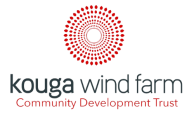OUR STRATEGIC INTENT
The Kouga Windfarm Community Development Trust (KWFCDT) recently adopted a new strategic intent that is premised on the theory of change model. The Trust’s intent is based on three pillars.
- Improving the quality of education and skills development
- Improving the quality of life and
- Reducing poverty – all this in the four communities of Kruisfontein, KwaNomzamo, Umzamowethu (Oyster Bay) and Sea Vista.
KWFCDT (The Trust) has in turn adopted a new operating model and is now geared to fulfil its vision and mission in a robust and cautiously focussed approach to achieve the desired development impact.
The Trust’s theory of change strategy says in its role as a catalyst, The Trust will focus on issues or systematic problems that stand in the way or prohibits our communities to become thriving, resilient, sustainable and empowered and the Trust will work collaboratively with others to achieve its vision and mission.

In the new organisation structure led by the General Manager, Prince Matonsi, a dynamic and well grounded resource was appointed as a Projects Operations Officer to drive the various projects and programmatic interventions. This position is supported by a Community Liaison Coordinator, whose role is to ensure communities and stakeholders remain well informed and fully consulted on the various interventions. The Trust has also appointed a Finance and Administration Officer to ensure the financial resources are administered prudently.
CATALYST
How The Trust Will Work
With its Vision to be a catalyst that empowers communities to be self reliant, resilient and sustainable, here is how the Trust will work:
One
As a catalyst to capacitate and support organisations that work within communities to ensure sustainable, thriving, resilient and empowered communities and individuals.
Two
Build social capital with an emphasis on well being, connectivity, participation, inclusivity and resilience.
Three
Support a healthy economy that preserves the balance between economic and social outcomes to achieve positive community capital.
Four
Develop partnerships across all sectors to maximize effectiveness and in the process create collaborative and collective capital and shared value.
LONG TERM DELIVERABLES
Here are the desired changes we envisage in our communities to enable our stakeholders to collaborate effectively with the Trust
Education & Skills Development
Improve access and quality of education
Improving access to quality education will lead to improved quality of teaching and learning. This will in turn lead to effective and efficient education systems that leads to improved employability and earning potential thereby reducing poverty.
SDG 4: Ensure inclusive and equitable quality education and promote lifelong learning opportunities for all
WELFARE AND HUMANITARIAN DEVELOPMENT
Create thriving, resilient, empowered and sustainable communities
Thriving, resilient, empowered and sustainable communities lead to reduced poverty and hunger, and increased health and well being. This results in reduced vulnerability and inequality, improved safety and security. The expected impact would therefore be reduced community vulnerabilty through the provision of basic services, skills and coping mechanisms that will lead to greater self sufficiency.
SDG 1: Reduce poverty (End poverty in all its forms everywhere)
ARTS, CULTURE AND SPORTS DEVELOPMENT
Improve social cohesion and inclusivity, and protect the heritage of communities
This will improve the community well being leading to reduced vulnerability and inequality, improved safety and security. The overal impact will be reduced community vulnerabilty through the provision of basic services, skills and coping mechanisms that will lead to greater self sufficiency.
SDG 11: Make cities and human settlements inclusive, safe, resilient and sustainable
ENTERPRISE DEVELOPMENT
Accelerate and support the development of high potential EMEs and SMEs
The acceleration and support of these entities will lead to improved profitability, resilience, survival and sustainability of local enterprises. This will result in increased business creation, improved job creation and job protection. The impact to be seen will be accelerated development and growth of the local economy.
SDG 8: Promote sustained, inclusive and sustainable economic growth, full and productive employment and decent work for all
HEALTHCARE DEVELOPMENT
Improve access to quality healthcare services
Quality healthcare services will lead to improved health care outcomes for individuals and families. This will result in reduced substance abuse, improved adherence to treatment plans and improved quality of service. This will positively impact and improve the quality of life within communities.
SDG 3: Ensure healthy lives and promote wellbeing for all at all ages
ENVIRONMENT, CONSERVATION AND ANIMAL CARE
Improve natural and environmental ecosystems
This will lead to increased awareness about the importance of natural ecosystems, resulting in reduced social, economic and environmental vulnerability and increased climate change resilience. The expected impact is sustainable communities that are resilient to climate change through environmental awareness, protection, restoration, conservation.
SDG 15: Protect, restore and promote sustainable use of terrestrial ecosystems, and halt and reverse land degradation and biodiversity loss
SDG 15: Protect, restore and promote sustainable use of terrestrial ecosystems, d halt and reverse land degradation and biodiversity loss
INFRASTRUCTURE DEVELOPMENT
Improve access to basic healthcare services
Access to basic healthcare services will lead to restored dignity and reduced abuse and exclusion. This will result in improved and enhanced quality of life and positively impact the communities by increasing access to quality care, basic services and reduced vulnerability.
SDG 11: Make cities and human settlements inclusive, safe, resilient, and sustainable

